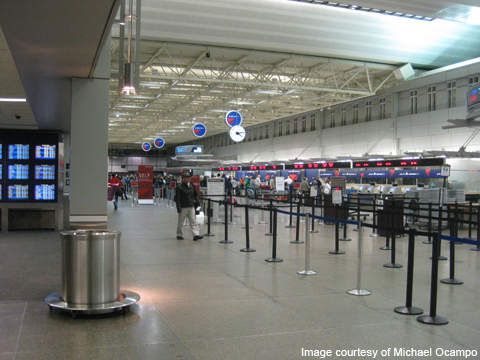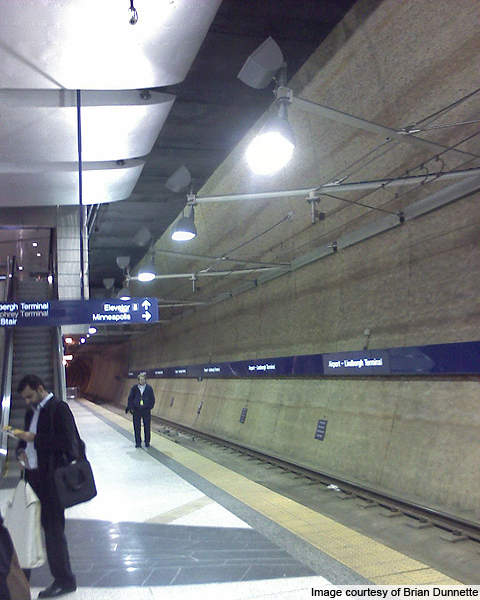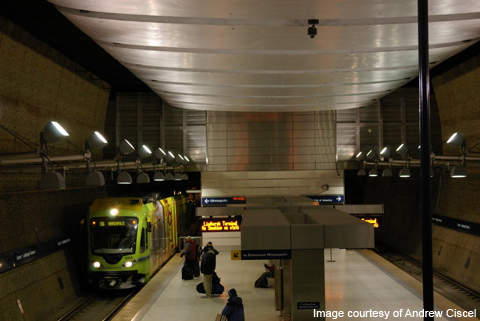Minneapolis-St Paul (MSP) International Airport lies between Minneapolis and St Paul and serves suburban areas such as Bloomington, Eagan, Mendota Heights and Richfield in the US state of Minnesota. It is operated by Metropolitan Airports Commission (MAC).
In 2010, the airport recorded 32.8 million passengers and 437,075 aircraft movements.
Airlines operating from MSP airport include Alaska Airlines, Air Canada, American Airlines, Continental Airlines, Delta Air Lines, Frontier Airlines, United Airlines, US Airways, Icelandair, Southwest Airlines, Sun Country Airlines and Air Tran Airways.
MSP airport was originally a Snelling speedway, an unsuccessful racing venue. It was procured by the Minneapolis Aero Club in 1920 and a wooden hangar was built. The 160-acre property, which was called the Speedway Field, was used for airmail service. It was renamed as World-Chamberlain field in 1923. The airport got its current name in 1948.
The airport is set for a strategic development to accommodate increased levels of passenger traffic by 2030. The project involves the expansion of the existing airport instead of constructing a new one.
2010 MSP master plan and expansion
MSP airport is built on a 3,400-acre site and has one airfield, four runways and two terminals: Terminal 1-Lindbergh and Terminal 2-Humphrey.
The airport underwent a $3.2bn expansion known as ‘MSP 2010: Building a Better Airport’.
Approved in 1996, the expansion was completed by 2009.
Among other developments, the plan included the replacement of a charter terminal with the ten-gate Humphrey terminal.
The expansion also involved runway and apron improvements, the development of a new north / south runway, the addition of 6,500 parking spaces at Terminal 1-Lindbergh and 9,500 parking bays at Terminal 2-Humphrey, 12 jet gates to Concourse C of terminal 1, three new de-icing pads, a new transit centre for the light railway and the development of new roadways, auto rental facilities and a children’s play area at both terminals.
2030 MSP expansion
MAC forecasts that passenger traffic at the airport will increase from 16.4 million to 28.4 million, a growth of more than 73% by 2030, while aircraft movements are expected to grow by 40% from 450,000 to 630,000.
Taking this into consideration, MSP’s long-term comprehensive plan was updated in July 2010. The main purpose of the plan is to improve the passenger facilities in four phases by 2030. The project is currently under environmental review for the first two phases.
Phase I will include the expansion of Terminal 2 to add 26 more gates to accommodate more airlines and the improvement of parking and access roads. The plan is to reserve Terminal 1-Lindbergh to Delta Air Lines and its partners and move all other services to Terminal 2-Humphrey.
This phase is expected to be completed by 2015 and is estimated to cost $380m-$445m.
Phase II is expected to continue between 2015 and 2020. The international arrivals facility at terminal 1 will be expanded under the phase as part of concourse G expansion. The baggage claim area will be installed with advanced baggage claim systems.
A new hotel will be built at the terminal during this phase. The phase is estimated to cost $810m to $960m.
Phase 3, planned for between 2020 and 2025, will see the expansion of Terminal 2-Humphrey, and is estimated to cost $665m to $783m. Phase IV will take place between 2025 and 2030 and will include the construction of crossover taxiways and the improvement of access roads at terminal 1. Works under this phase are estimated to cost $190m to $225m.
Screening and security
The US transportation systems are secured by the Transportation Systems Administration (TSA) agency, which is a part of the Department of Homeland Security. The international checkpoint is at concourse G in terminal 1. There are six checkpoints at the terminal’s ticketing level. The checkpoint in terminal 2 is at the second level. Advanced imaging technology machines are installed at the checkpoints.
An additional security checkpoint is expected to be added to the northern end of the terminal near the new skyway entrance to enhance the security screening process.
MSP terminals
Terminal 1-Lindbergh is named after the aviator Charles Lindbergh. It has seven concourses, A-G, and spreads over an area of 2.8 million square feet. The concourses are on the second level.
Concourses A and B opened in 2002 and have a total of 30 gates. Expansion of concourse C by 16 gates was also completed in 2002. An elevated tram connects concourse C with D. A skyway connects concourse C on the north and G on the south to the parking and car rental areas.
The 450,000 square feet terminal 2, which is named after former vice-president Hubert Humphrey, opened in May 2001 and serves Southwest Airlines, Sun Country Airlines, Air Tran Airways and the airport’s charter airlines.
The terminal was expanded to ten gates (from the original eight) in December 2004. The terminal has an international arrivals facility, a full-service restaurant and shops. It is connected to the parking facility through a skyway.
Parking
Terminal 1-Lindbergh includes a nine-level parking ramp with 6,500 spaces for vehicle parking. Motorcycle parking and oversized vehicle parking are prohibited at the airport terminals.
Terminal 2-Humphrey is connected to a 4,700-space ramp. An additional 4,500-space ramp was added in 2009.
Bicycle racks are available at both terminals.
Runways
MSP airport has four runways. Runway 4 / 22 is the airport’s crosswind runway and was originally built in 1960s. It underwent reconstruction later. 12R / 30L is the south parallel runway and 12L / 30R is the north parallel runway.
The fourth runway 17 / 35 was commissioned in October 2005. The 8,000ft runway intersects with the crosswind runway.
Transportation at MSP airport
Terminal 1 is connected to Minnesota State Highway 5 while the Terminal 2 is reachable through the 34th Avenue exit from I-494.
The Hiawatha Line light-rail service stops at both the terminals. It acts as a connection between the two terminals, as well as connecting the airport to downtown Minneapolis and Bloomington. The Lindbergh Terminal station is underground while the line comes over ground near Humphrey Terminal.





